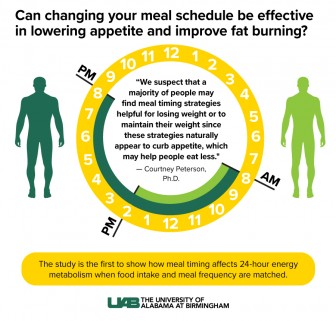UAB Study Shows Limiting Meal Times Can Lower Appetite
Researchers have known for a while that eating earlier in the day when metabolism rates are higher can help with weight loss. So can consuming all meals within a narrow window of time and then fasting for several hours.
“But there was a big question, like why does it help with weight loss?” Courtney Peterson, assistant professor in UAB’s Department of Nutrition Sciences, says. “Is it because it helps people burn more calories, or is it because it makes them less hungry, or both?”
To try to answer that question, Peterson and fellow researchers conducted a study to measure changes in appetite levels and the number of calories people burn when they use Early Time-Restricted Feeding (eTRF), a form of intermittent fasting.
Participants tried two different meal schedules. They spent four days eating from 8 a.m. to 8 p.m., the average schedule for an American adult, and they spent another four days eating the same meals between 8 a.m. and 2 p.m, a version of eTRF.
On the fourth day of each meal schedule, participants remained in a controlled environment for 24 hours so researchers could measure data including levels of the hunger hormone Ghrelin.

Peterson says the results were a bit surprising. They found that the eTRF schedule did not help participants burn more calories, but it did help them burn more fat and it lowered their appetite levels.
“That’s still a major victory,” Peterson says, “because if you can make people naturally less hungry, then that’s going to help them not only with weight loss, but with maintaining their weight.”
Researchers enrolled 11 overweight men and women, a small but appropriate sample size, according to Peterson. The study was published online Wednesday in the journal Obesity.
Peterson says the next step is to test whether people are able to consistently follow the restricted meal schedule and whether it can actually help people lose weight.
Photo by Pixabay
Editor’s Note: WBHM is a member-supported service of UAB, but our newsroom and business operations are separate.
Why haven’t Kansas and Alabama — among other holdouts — expanded access to Medicaid?
Only 10 states have not joined the federal program that expands Medicaid to people who are still in the "coverage gap" for health care
Once praised, settlement to help sickened BP oil spill workers leaves most with nearly nothing
Thousands of ordinary people who helped clean up after the 2010 BP oil spill in the Gulf of Mexico say they got sick. A court settlement was supposed to help compensate them, but it hasn’t turned out as expected.
Q&A: How harm reduction can help mitigate the opioid crisis
Maia Szalavitz discusses harm reduction's effectiveness against drug addiction, how punitive policies can hurt people who need pain medication and more.
The Gulf States Newsroom is hiring a Community Engagement Producer
The Gulf States Newsroom is seeking a curious, creative and collaborative professional to work with our regional team to build up engaged journalism efforts.
Gambling bills face uncertain future in the Alabama legislature
This year looked to be different for lottery and gambling legislation, which has fallen short for years in the Alabama legislature. But this week, with only a handful of meeting days left, competing House and Senate proposals were sent to a conference committee to work out differences.
Alabama’s racial, ethnic health disparities are ‘more severe’ than other states, report says
Data from the Commonwealth Fund show that the quality of care people receive and their health outcomes worsened because of the COVID-19 pandemic.







